Do you agree or disagree Whenever possible I always prefer t
Do you agree or disagree: Whenever possible, I always prefer to sell my products to as many segments as possible. Discuss in length
Solution
Market Segmentation
The purpose for segmenting a market is to allow your marketing/sales program to focus on the subset of prospects that are \"most likely\" to purchase your offering. If done properly this will help to insure the highest return for your marketing/sales expenditures. Depending on whether you are selling your offering to individual consumers or a business, there are definite differences in what you will consider when defining market segments.
Category of Need
The first thing you can establish is a category of need that your offering satisfies. The following classifications may help.
For businesses:
For the individual consumer:
Segmentation of Needs
Then you should establish what the need is and who is most likely to experience that need. Your segmentation will be determined by a match between the benefits offered by your offering and the need of the prospect. Some \"need\" categories for segmentation include:
Reduction in expenses
Prospects might be businesses that are downsizing (right sizing), businesses that have products in the mature stage of their life cycle or individuals with credit rating problems.
Improved cash flow
Prospects might be businesses that have traditionally low profit margins, businesses that have traditionally high inventory costs or individuals that live in expensive urban areas.
Improved productivity
Prospects might be businesses that have traditionally low profit margins, businesses that have recently experienced depressed earnings or individuals with large families.
Improved manufacturing quality
Prospects might be businesses with complex, multi-discipline manufacturing processes.
Improved service delivery
Prospects might be service businesses in highly competitive markets, product businesses requiring considerable post-sale support or individuals in remote or rural areas.
Improved employee working conditions/benefits
Prospects might be businesses where potential employees are in short supply.
Improvement in market share/competitive position
Prospects might be new entrants to a competitive market.
Need for education
Prospects might be businesses or individuals looking for books on business planning, or seminars on Total Quality Management.
Involvement with social trends
Prospects might be businesses concerned with environmental protection, employee security, etc. or individuals who believe in say \'no\' to drugs, anti-crime, etc.
Specific - relating to product/service characteristics
Prospects might be businesses or individuals interested in safety, security, economy, comfort, speed, quality, durability, etc.
Factors that segment prospects
Having determined the more general segmentation characteristics you can proceed to a more detailed analysis of the market. There are literally thousands of ways to segment a market, but the following are some of the more typical segmentation categories.
For businesses:
Industry by SIC code
This is especially beneficial for vertical market offerings.
Size - revenues, # employees, # locations
In general if your offering is highly sophisticated, requires significant resources or provides greater value based on volume, then the target should be the larger enterprises.
Job position/responsibility
Examples of offerings might be planning software for managers or cleaning agents for maintenance managers.
Climate
Examples of offerings might be dehumidifiers in areas near the ocean or snow plows in northern areas.
Time related factors
Some services in this category are vacation related industries in summer and tax planners in the spring.
Language
An example of a language specific service is a Spanish TV channel.
Status in the industry
You might want to target businesses that are the technology leader or revenue leader or employee satisfaction leader, etc.
Accessibility
To minimize promotion and sales expense you may want to target urban rather than rural or local rather than national prospects.
Future potential
A good example is how Apple Computer supplied products to schools at all levels to condition students graduating into the marketplace.
Ability to make a quick purchase decision
Targeting individual purchasers versus business committees can significantly reduce marketing expense and increase the probability of a quick close.
Access (or lack of access) to competitive offerings
Cable TV business\'s significant investment in their service delivery system has allowed a near monopoly for some time. IBM\'s service reputation insured minimal competition during the mainframe days.
Need for customization
Offerings such as police cars, busses for municipalities and specialized computer systems fall into this category.
Product or service application to a business function
Examples are data processing, accounting, human resources and plant maintenance.
For Individual Consumers:
Physical Size
Offerings might be big men\'s clothing, golf clubs for shorter players, etc.
Creation of or response to a fad
Examples are hula hoops, Jurassic Park T-shirts, pet rock, physical fitness, etc.
Geographic location
Marketers take advantage of location by selling suntan lotion in Hawaii, fur coats in Alaska, etc.
Time related factors
You may be able to target vacationers in summer, impulse buyers during the holidays or commuters at 7AM.
Demographics/culture/religion
Ethnic products would fall into this category.
Gender
Product examples are scarves for women, ties for men, etc.
Age
Product examples are toys for children, jewelry for women, etc.
Social status
This could include country club memberships, philanthropic contributions, etc.
Education
Product and service examples are encyclopedias, scientific calculators, learning to read tools and financial counseling.
Avocation
This could include products for hunting, fishing, golf, art work, knitting, etc.
Special Interests
You could target cat lovers, science fiction readers, jazz music collectors, etc.
Accessibility
Because the individual is more difficult to reach you may want to segment by urban versus rural, train commuters, people who read Wall Street Journal, etc.
Access (or lack of access) to competitive offerings
Due to high investment capital requirements or timing of market entry you may be able to capture a significant market share in a specific geographical area. Examples might be a trash service, emergency medical support, etc.
Need for specific information
Based on features or content of your offering you can target a market segment. A product might be books on how to start a business or a service might be seminars on how to quit smoking.
Need for customization
Product/service examples are home decoration, fashion wear, personal portraits, etc.
Need for quality, durability, etc.
Product examples are mountain climbing gear, carpenter\'s tools, etc.
Degree of a product/service ingredient
Segmentation based on prospect preferences is common. An example is dark chocolate for some tastes, light chocolate for others.
Purchase decision influencers
Once you have isolated a specific segment of the market on which to focus, then you can consider more subtle influences on the purchase decision. Some of these are:
Preference for channel of distribution
Many prospects prefer to buy through a specific distributor or wholesaler. For individuals this may be due to subtle, as well as, economic reasons. For example, an individual prospect may immediately think of Wal-Mart or Home Depot when considering an offering like yours. A business often has a preference so they can have a single communication point for all purchases. This also often results in lower purchase prices.
Number of decision makers
When selling to consumers or businesses, the more individuals or groups involved in the purchase decision, the more difficult the sale. Marketing costs for selling bread can stay low because one person normally makes the purchase decision. Car purchases are more complex because the purchase decision normally involves a husband and wife. Business sales to committees often require months to achieve a decision.
Financial strength of the prospect
Less affluent prospects may desire time payments versus a cash purchase and Chevrolets instead of Cadillacs.
Quantity/volume requirements
Restaurants will want large jars of pickles while individuals want small jars. Businesses use large amounts of electricity at predictable times.
Ability to use the offering
Trying to sell to a prospect who lacks either the knowledge or resources to properly benefit from your offering will result in a \'no sale\' situation or an unhappy customer. The prospect should have knowledge and resources such as time, equipment, facilities, personnel and complementary products/services.
Commitment required
If the offering requires a high commitment in terms of time, resources or money by the customer then the target should be prospects who \'really need\' the offering rather than prospects who get some, but not a lot, of benefits.
Brand awareness/users
Examples are prospects who ask for IBM compatible PC\'s or Pitney Bowes mailing machines or Winnebago R.V.s
Attitude toward a personality or enterprise
Reputation helps sell AT&T long distance service, IBM computers, Michael Jordan tennis shoes, etc.
Attitude toward price versus value
For example, purchasers of collectors items aren\'t price sensitive while purchasers of commodity items are price sensitive.
Experience with other products/services your enterprise has offered
You are looking for a reaction like \"I liked your first product so I\'ll try your second.\"
Prospect bias
Examples are, \'Buy USA\', I want a car with a \'solid\' feel, fast cars, sweet wines, large print playing cards, etc.
Affiliation with other organizations
Such as the U.S. Chamber of Commerce, AMA, IEEE, doctors, attorneys, pastors, franchisors, entrepreneurs, etc.
After sale support expectations
It is often beneficial to target prospects who have enough expertise that they will require a minimum of after sale support.
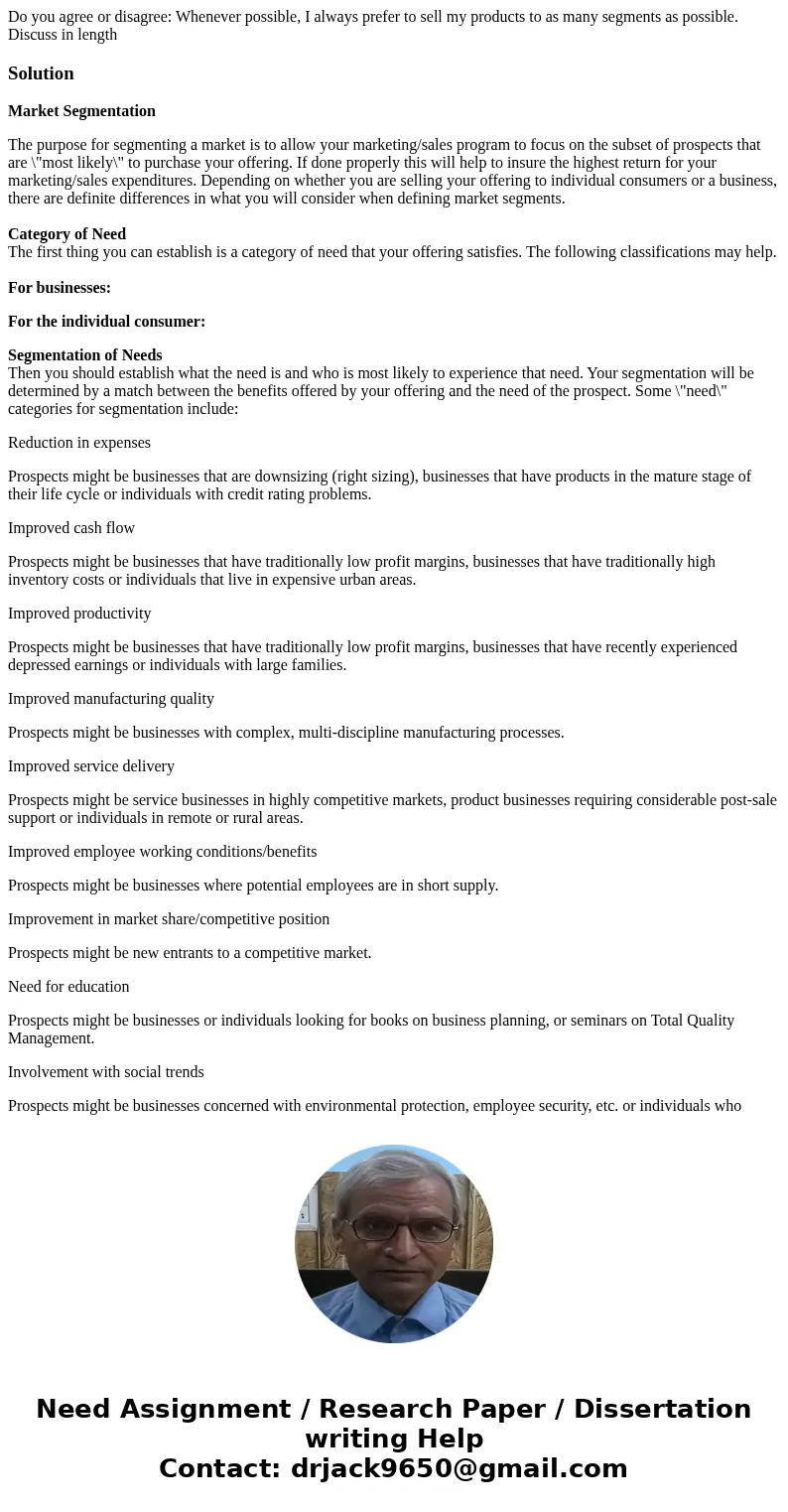
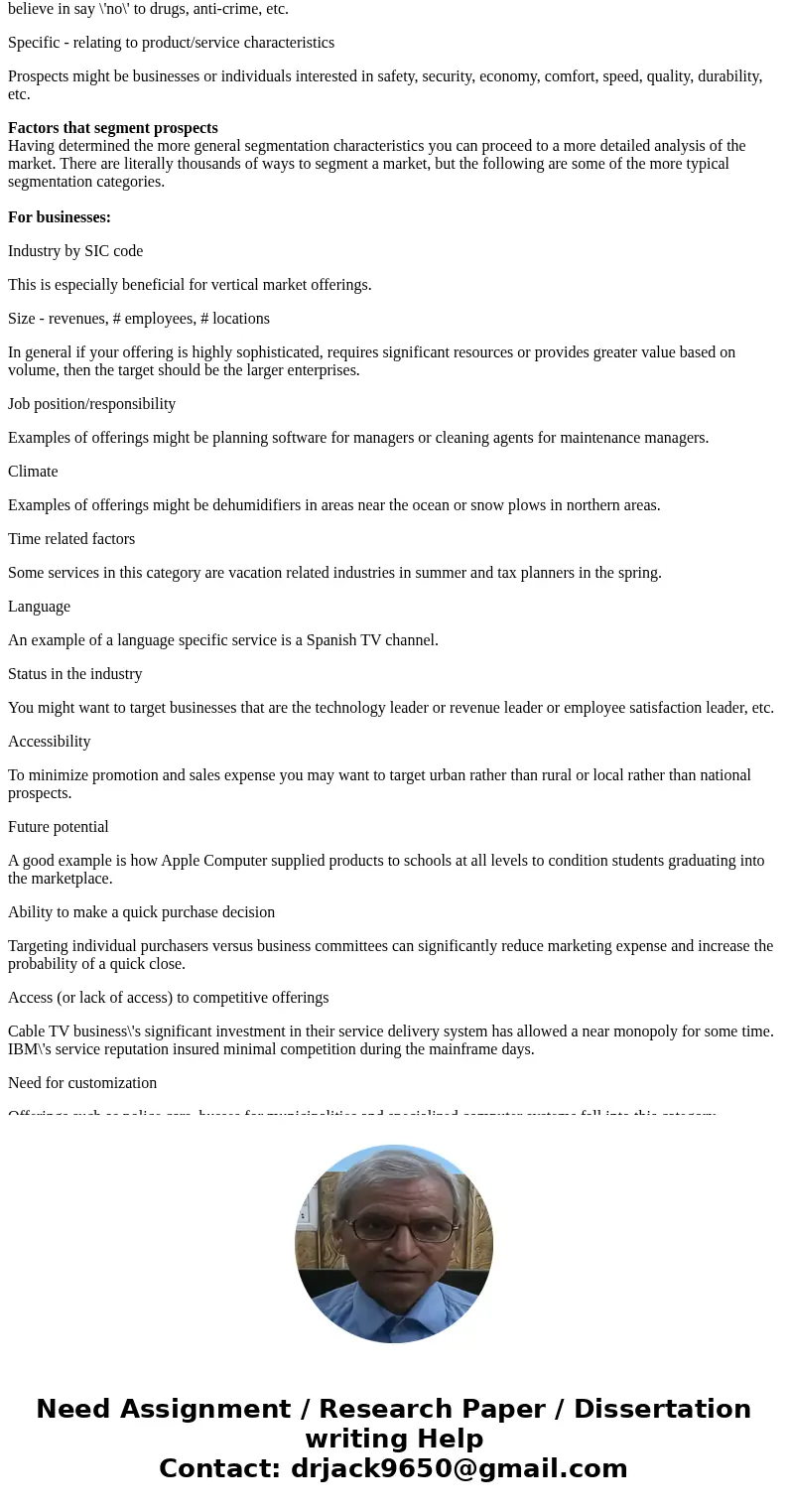
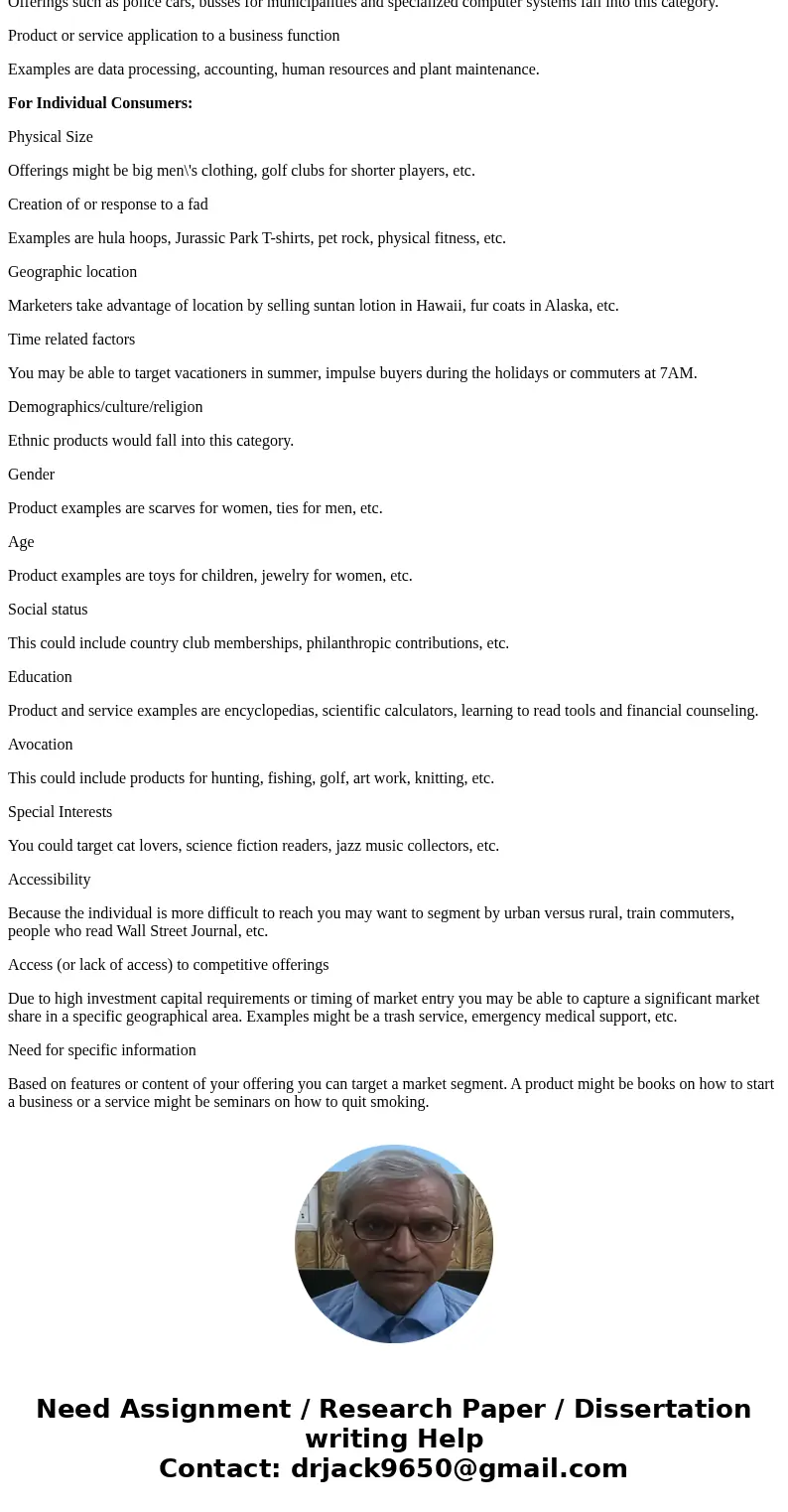
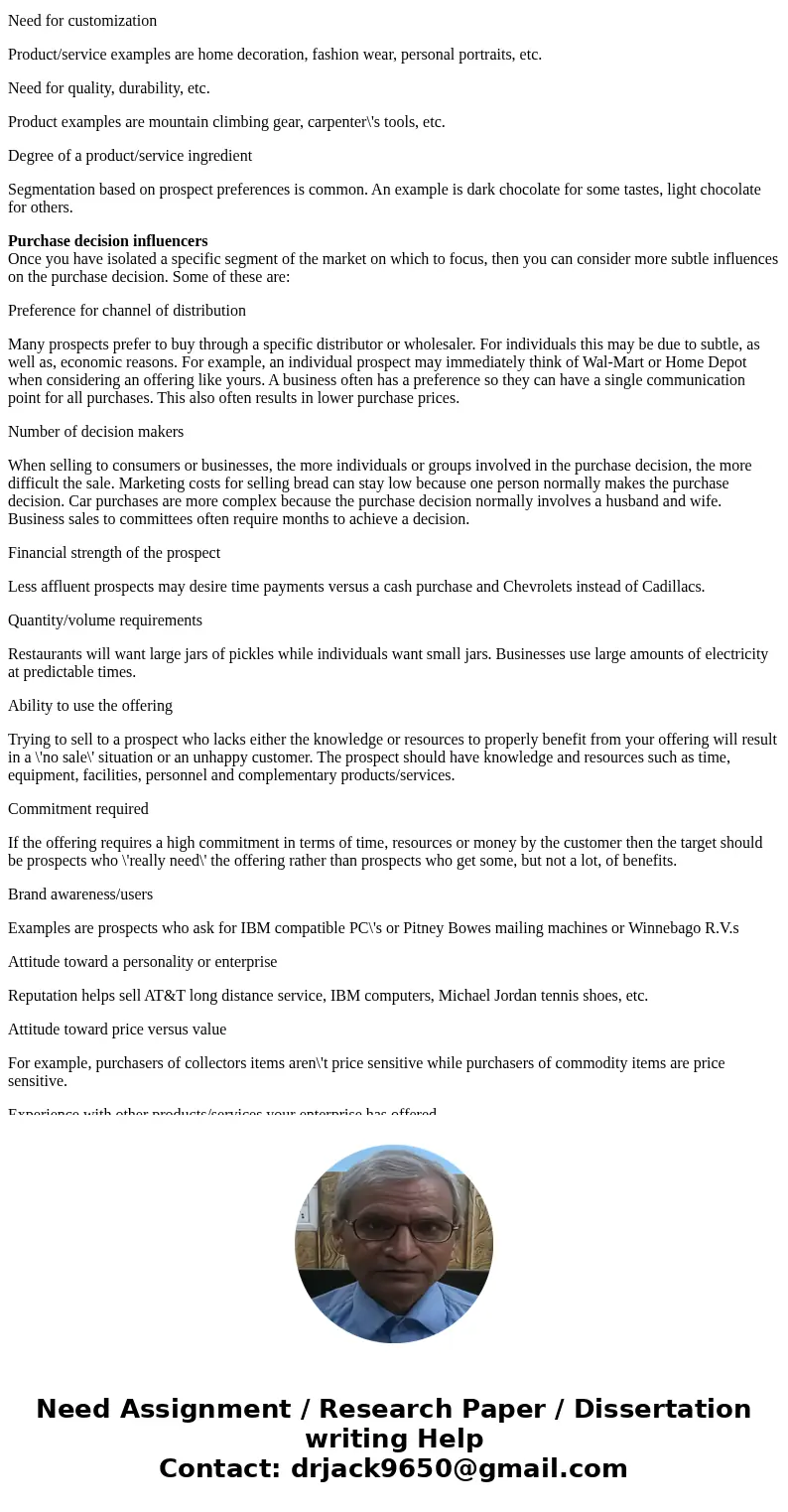
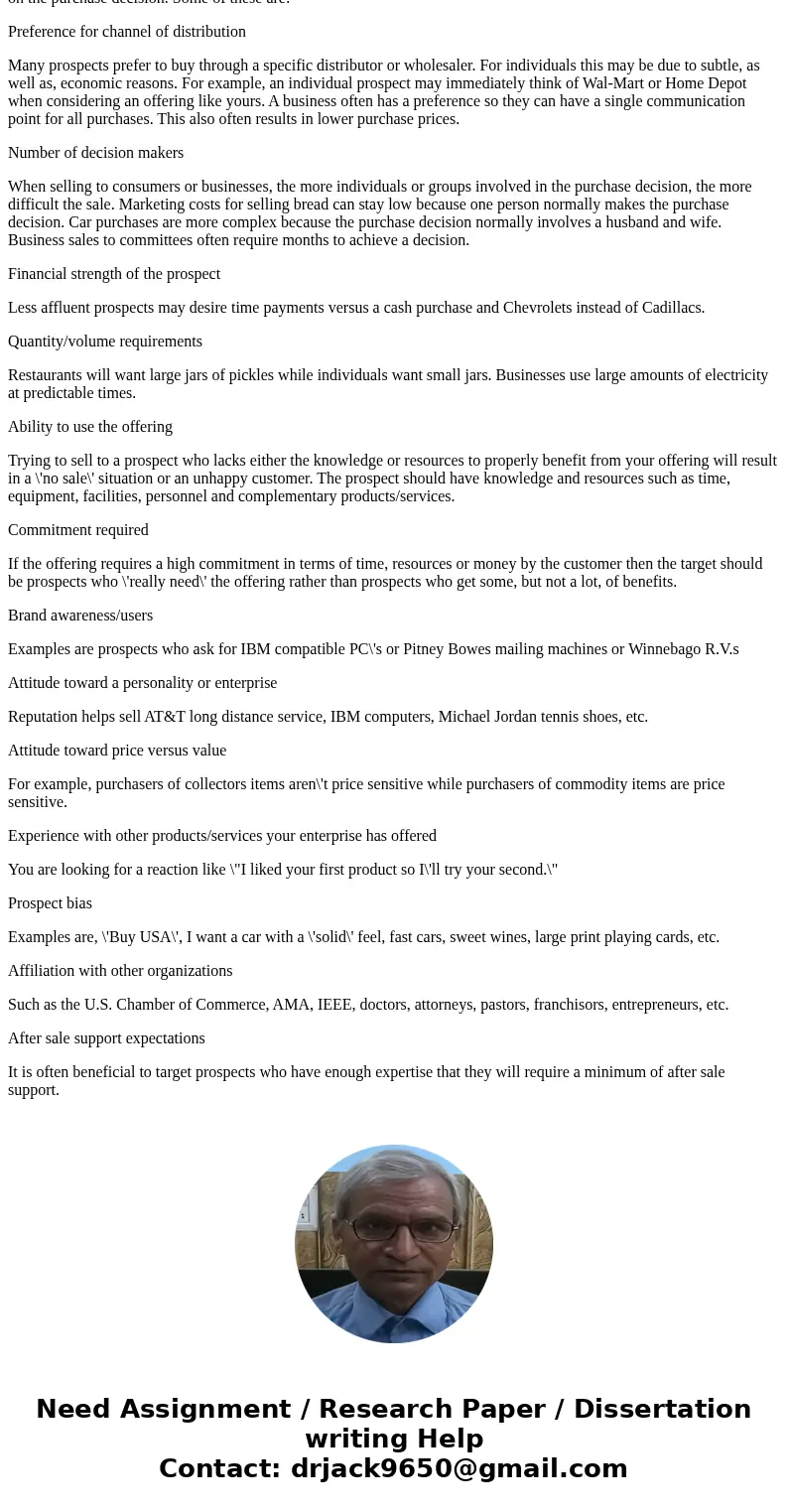
 Homework Sourse
Homework Sourse